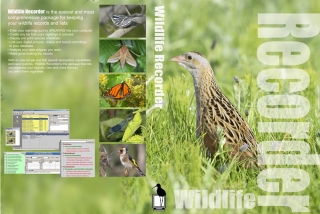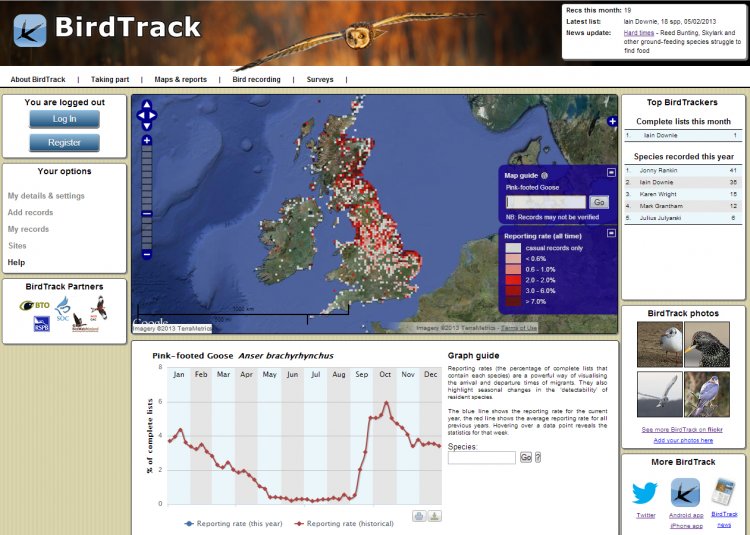Sightings
The latest Lincolnshire Bird News can be seen at https://www.lincsbirdclub.co.uk/site/index.php/sightings/latest-news.
Why record birds?
Keeping a record of the birds we see is one of the most useful aspects of our birdwatching. Although you may not think your own personal records are very significant, when you combine them with records from other birdwatchers in the county they provide a valuable historical record. Over time, records can be compared and will give between year changes in the patterns of occurrence of common species as well as details of breeding, distribution and movements.
Recording birds regularly from the same site can contribute to a greater understanding of the ornithological value of the site and may provide important information for site safeguarding and to evaluate the effects of site management. This gives real conservation value to your records.
To report news of a recent bird sighting or records of all your sightings, there are a number of ways you can do this.
Lincolnshire Latest News:
The latest Lincolnshire Bird News can be seen at https://www.lincsbirdclub.co.uk/site/index.php/sightings/latest-news. This page will be updated on a regular basis, to provide a convenient news service to scarce & rare birds found within Lincolnshire. This is a free service and members wishing to get more up to the minute information should check commercial news services. A copy of Archive news can be found at https://lincsbirdclub.co.uk/site/index.php/sightings/lbc-archived-sightings.
WhatsApp Rare & Scarce Bird News (Members ONLY)
A group dedicated to informing Lincolnshire Bird Club members of rare birds in the county. The group is for news of rare birds (LBRC/BBRC rarities).
The rules are simple
1) Reporting new LBRC/BBRC rarities in Lincolnshire
2) BBRC rarities heading toward Lincolnshire e.g Cliff Swallow south at Spurn
3) No chit chat
Admins reserve the right to remove any member deviating from the rules. By joining the group you accept that your mobile number is being shared with others in this group with your agreement. For more information click here.
Twitter:
For short messages to get the news out to other club members, it's best to use the Lincs Bird Club Twitter Feed. Anyone who follows Lincs Birding on Twitter will get the news and those who are not Twitter members can view our Twitter feed on the home page of this website.
Its important that when you do your tweet you Include the text @Lincsbirding to ensure the message is retweeted increasing the chances of the news spreading more quickly.
The LBC Forum:
Only Members have access to our forum and its here they post what they have seen around the county. Simply post what you have seen, where and when you saw them, and post an image if you have one (however poor, often still of value!). These records are picked up every month and added to the county records database.
Use the LBC Records Template:
Both Twitter and the Forum records have to be sorted and transfered to the county records database by volunteers and this can take a lot of time.
The best way to send in records is to download our microsoft Excel Spreadsheet template and fill it in. We will check the data format and make any necessary changes and then import the records into the LBC records database. This is the easiest and most productive way of submitting your records. Most recording software packages can export to a .csv or .xls format and these exports take very little time to sort out. Once you have your template filled in, simply email it to the Database controllers.
Download the LBC Template HERE
Rare birds to the County
Those species that are scarce or rare in Lincolnshire, and that are rare nationally, have to be recorded in a different way. In these cases, please send a description to the area county recorder along with any images taken. The simplest way to do this is by using our online form by clicking on the green "Submit a record click here" button below, and entering all the details requested.
These are then checked and adjudicated on by the Lincolnshire Rare Birds Committee (LBRC) and those accepted are entered in the Lincolnshire Bird Report for that year. The LBRC review each record and make the final decision. If a record is not accepted, the verdict will always be "Not proven" rather then "Rejected" and this usually means the details of the description on paper were inadequate to prove the identity beyong doubt. A list of the birds reviewed by the LBRC can be found on this site by viewing the "Lincs List" when "LBRC" appears after the species name.
National Rare Birds
Nationally Rare Bird records have to be sent to the British Birds Rarities Committee (BBRC) following their procedure which can be found on their website.

















